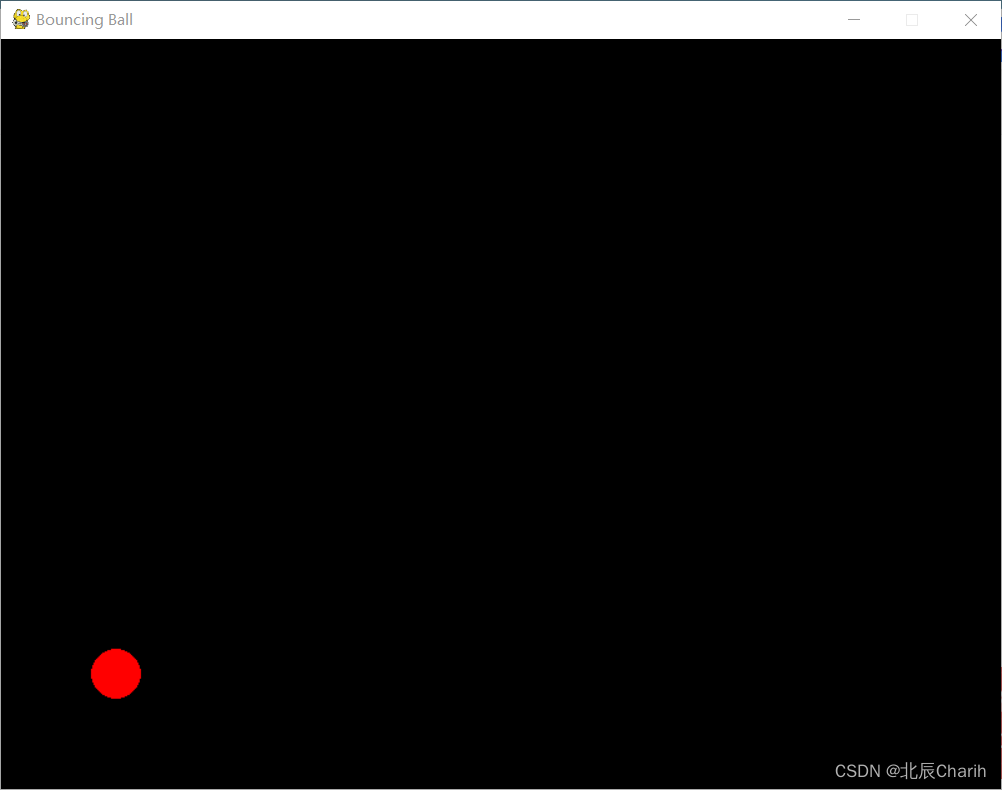编写一个弹跳小球的程序,小球在窗口中四处反弹(python)
发布时间:2024年01月06日
import pygame
import random
# 初始化Pygame
pygame.init()
# 窗口尺寸
width = 800
height = 600
# 创建窗口
screen = pygame.display.set_mode((width, height))
pygame.display.set_caption("Bouncing Ball")
# 小球初始位置和速度
ball_radius = 20
ball_color = (255, 0, 0)
ball_pos = [random.randint(ball_radius, width - ball_radius), random.randint(ball_radius, height - ball_radius)]
ball_speed = [random.randint(1, 5), random.randint(1, 5)]
# 游戏主循环
running = True
while running:
# 处理事件
for event in pygame.event.get():
if event.type == pygame.QUIT:
running = False
# 更新小球位置
ball_pos[0] += ball_speed[0]
ball_pos[1] += ball_speed[1]
# 检测小球与窗口边界碰撞
if ball_pos[0] < ball_radius or ball_pos[0] > width - ball_radius:
ball_speed[0] = -ball_speed[0]
if ball_pos[1] < ball_radius or ball_pos[1] > height - ball_radius:
ball_speed[1] = -ball_speed[1]
# 填充背景色
screen.fill((0, 0, 0))
# 绘制小球
pygame.draw.circle(screen, ball_color, (int(ball_pos[0]), int(ball_pos[1])), ball_radius)
# 刷新屏幕
pygame.display.flip()
# 退出游戏
pygame.quit()
在这个程序中,使用random模块来随机生成小球的初始位置和速度。然后,在主循环中,不断更新小球的位置,并检测小球是否与窗口边界发生碰撞,如果发生碰撞,则反转小球的速度。然后,使用pygame.draw.circle()函数来绘制小球,并使用pygame.display.flip()函数刷新屏幕。
运行这段代码后,将看到一个窗口中弹跳的小球。小球会在窗口中四处移动并反弹,直到关闭窗口为止。可以根据需要调整窗口大小、小球的半径、颜色以及移动速度等参数来定制属于自己的弹跳小球游戏。

文章来源:https://blog.csdn.net/m0_62110645/article/details/135419324
本文来自互联网用户投稿,该文观点仅代表作者本人,不代表本站立场。本站仅提供信息存储空间服务,不拥有所有权,不承担相关法律责任。 如若内容造成侵权/违法违规/事实不符,请联系我的编程经验分享网邮箱:chenni525@qq.com进行投诉反馈,一经查实,立即删除!
本文来自互联网用户投稿,该文观点仅代表作者本人,不代表本站立场。本站仅提供信息存储空间服务,不拥有所有权,不承担相关法律责任。 如若内容造成侵权/违法违规/事实不符,请联系我的编程经验分享网邮箱:chenni525@qq.com进行投诉反馈,一经查实,立即删除!
最新文章
- Python教程
- 深入理解 MySQL 中的 HAVING 关键字和聚合函数
- Qt之QChar编码(1)
- MyBatis入门基础篇
- 用Python脚本实现FFmpeg批量转换
- 如何通过HACS+Cpolar实现远程控制米家和HomeKit等智能家居设备
- 第10章 实战开发—制作油纸伞网站首页
- 【H3C UniServer R4900 G3 服务器配置Raid 安装VMWare Esxi 6.7记录】
- 和GPT讨论知识蒸馏的基本概念
- 冰蝎4.0jsp木马浅析
- web3简述
- 肺癌相关文献6
- Trie树的个人理解与总结
- 案例1—综合项目组网(1)
- springBoot-Dev tools、Lombok、Spring initializr